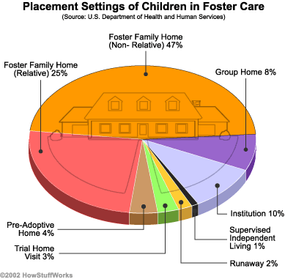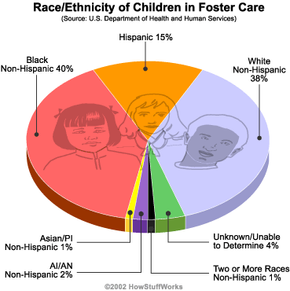The Organization
In the United States, foster care operates on the local level, rather than on the national level. The structure varies somewhat from state to state, as do the specific names for government agencies and programs, but most states follow the same general model.
In most cases, the state's division of social services, part of the state department of health and human services, heads up the entire system. These agents oversee county social services departments as well as private foster care agencies. This is one of the most misunderstood facts of foster care: While government regulations generally direct how foster care operates, independent non-profit organizations (licensed by the state) do a huge amount of the actual work in some areas. These organizations generally receive government funds, but they may also depend on charitable donations.
Advertisement
It's up to the county departments and the private agencies to take care of the details of foster care. Adhering to the state's specific regulations, caseworkers with local organizations train foster parents, place children in foster homes, work with families towards reunification, work with local adoption agencies to find new permanent homes for children and generally keep track of everything involved in each foster child's progress through the system.
Foster care agencies typically consider the group of people working with a particular child as a team. The core members of the team are the foster parents, the biological parents, the court, the social worker in charge of the case and, most importantly, the child him or herself. The team's job is to look out for the best interests of the child and work towards putting the child in a permanent home.
In addition to this core group, several other volunteers and professionals may become part of the team from time to time. For example, an attorney with the state Office of the Child Advocate may represent the child legally, and the court may also assign a Court Appointed Special Advocate, a volunteer who studies the case and supports the child in court.
There are a number of different types of foster care. In traditional care, a relatively small number of children stay with a family or a single foster parent in their home for a matter of months or years. Traditional foster care may also operate on a short-term basis, of a few days to a month, for children who will be reunited with their families quickly.
Emergency foster homes are available 24 hours a day to take children in until the social services system can figure out a longer term solution. If a child's parents were arrested, for example, social services might put the child in an emergency foster home until they could locate relatives or find another place for the child.
Respite foster care families take children in for a couple days at a time, to give stressed families a periodic break. Relief care families work similarly, taking foster children for a short period of time to give their regular foster families a break.
Some foster children live in a group home instead of a traditional foster home. Foster care group homes function less like conventional families, and more like dormitories. While foster care agencies prefer to place children with families, a shortage of foster parents means many children end up in this sort of home. Additionally, foster care agencies may place children with special needs in group homes where they can get the professional assistance they need.

The predominant form of foster care is still ordinary people serving as foster parents. In the next section, we'll look at the typical process of becoming a foster parent.
